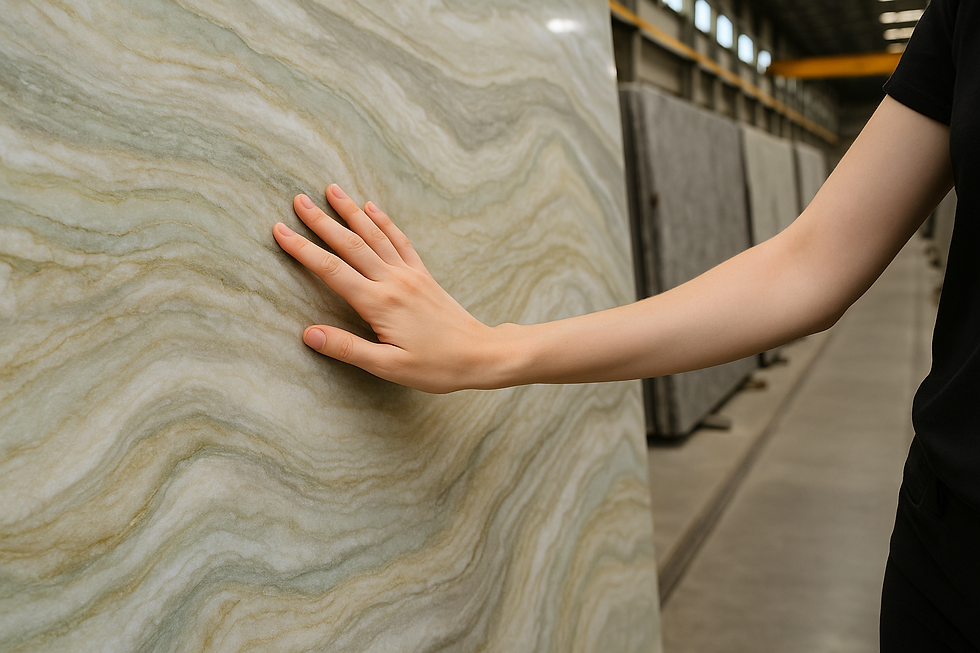Natural Stone Sector in Crisis: U.S. Imposes Tariff and Quartzite Becomes the Only Escape
- Igor Caetano
- Aug 1
- 4 min read

U.S. Mega-Tariff Hits Brazilian Stone Industry Hard, but Quartzite Dodges the Axe
Starting August 1, 2024, the United States will impose a 50% tariff on various Brazilian products, including natural stones such as granite and marble. The so-called “mega-tariff” is a result of the Section 301 review, reigniting trade tensions with multiple countries, Brazil among them. The damage began even before the official start date.
In July alone, over 1,100 containers were not shipped, which could represent up to $40 million in direct losses for Brazil. In Espírito Santo—the state responsible for over 80% of the country’s natural stone exports—the impact is devastating. Companies are halting production, renegotiating contracts, and canceling orders.
Already struggling with rising logistical costs and international competition, the industry now enters survival mode. The U.S. is Brazil’s top buyer in this sector, purchasing more than half of all stone exports.
Quartzite Exempt from Tariffs: A Breath of Relief
Amid the chaos, a single exception brought some relief: Brazilian quartzite was left off the tariff list. While it doesn’t solve the overall crisis, it helps keep part of the market alive and prevents total collapse.
Quartzite was already gaining prominence in exports and now acts as a temporary shield against disaster. It’s estimated that quartzite accounts for up to 40% of the total value of Brazil’s slab exports to the U.S.
But hold on—this doesn’t save anyone. It just buys time. The overreliance on the U.S. market remains a major vulnerability.
What Are Quartzite, Granite, and Marble?
In the midst of this crisis, many are wondering: what exactly are these stones, and why do they matter so much?
Granite is an igneous rock, formed from the slow cooling of magma. It’s durable, comes in a wide variety of colors, and is widely used for countertops and flooring.
Marble is a metamorphic rock, formed from limestone, known for its classic beauty and striking veining—but it’s more porous and delicate.
Quartzite is also a metamorphic rock, but much harder than marble. It forms from sandstone under intense heat and pressure, offering high resistance to scratching, heat, and abrasion. Its appearance often resembles marble, making it a favorite in modern design.

Brazil on the Edge, Espírito Santo Under Pressure
Espírito Santo is facing a critical moment. The stone sector is a key economic driver for the state, generating thousands of direct and indirect jobs and supporting a supply chain that spans from quarrying to processing to export.
With a 50% tariff on products like granite and marble, the U.S. is shifting to other suppliers—India, Turkey, China, and Italy—who continue exporting without extra charges. This leaves Brazil out of the game.
The reaction was swift. The Espírito Santo government has joined forces with organizations like Centrorochas and Sindirochas to push for exemptions and emergency measures. A delegation is preparing to travel to Washington to open dialogue with the USTR and key players in the U.S. construction sector.
What Now?
Quartzite’s exemption brings some relief, but the sector is far from safe. Diversifying markets is more urgent than ever. Europe, the Middle East, and Asia are back on the radar. Meanwhile, the domestic market—which surpassed exports for the first time in 2023—needs to be re-energized.
Brazil’s natural stone industry, especially in Espírito Santo, is facing one of the biggest challenges in its recent history. The threat isn’t in the quarries—it’s at the negotiation table, in global competitiveness, and in how fast Brazil can adapt.
This tariff isn’t just a tax. It’s a wake-up call. And if you don’t act now, you’ll be just another stone in the way.
In Short — If You Still Don’t Understand the U.S. Tariff:
The U.S. will impose an extra tariff of up to 50% on several Brazilian products starting in August 2025. The natural stone sector is in the crosshairs, which could block exports, cause multimillion-dollar losses, and leave countless containers stuck.
But here’s the catch: polished or brushed slabs of quartzite, granite, and marble are exempt, as long as they are correctly classified in the documentation.
In other words:Exported correctly = no tariffIncorrect classification = high cost (literally)
This exception is the industry’s only loophole right now. So if you export, treat documentation as a top priority. The difference between profit and disaster might be just four digits in a code.
🔍 Pay close attention to the correct codes:
✅ Polished or Brushed Slabs • Brazil NCM: 6802.99.00 • U.S. HTSUS: 6802.99
❌ Raw Blocks (Unfinished) • NCM: 2515 and 2516 • Will be charged the full 50% tariff
📋 What to Do Now:
Review all invoices, packing lists, and technical reports
Confirm that products are properly classified
Avoid reclassifications and penalties upon U.S. entry
Prioritize the export of finished slabs – they remain tariff-free
Bottom line:
Correct classification = smooth export
Wrong classification = guaranteed loss
Share this with your sales team, customs brokers, and U.S. clients.
The fiscal war has already begun.








Comments